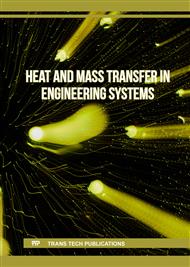[1]
T. Dursun, C. Soutis, Recent developments in advanced aircraft aluminum alloys, Mater Des. 56(2014) 862-871.
DOI: 10.1016/j.matdes.2013.12.002
Google Scholar
[2]
F. Vatansever, A.T. Erturk, E. Feyzullahoglu, Effect of ultrasonic melt treatment on the tribological behavior of 7075 aluminum alloy, Mater Test. 62(2020) 1243-1250.
DOI: 10.3139/120.111610
Google Scholar
[3]
J. C. Williams, E. A. Strake, Progress in structural materials for aerospace systems, Acta Mater. 51(2003) 5775-5799.
Google Scholar
[4]
J. S. Robinson, R. L. Cudd, D. A. Tanner, G. P. Dolan, Quench sensitivity and tensile property inhomogeneity in 7010 forgings, J Mater Process Technol. 119(2001) 261-267.
DOI: 10.1016/s0924-0136(01)00927-x
Google Scholar
[5]
J. S. Robinson, D. A. Tanner, C. E. Truman, 50th Anniversary Article: The Origin and Management of Residual Stress in Heat-treatable Aluminium Alloys, Strain. 50(2014) 185-207.
DOI: 10.1111/str.12091
Google Scholar
[6]
A. Sugianto, M. Narazaki, M. Kogawara, A. Shirayori, A comparative study on determination method of heat transfer coefficient using inverse heat transfer and iterative modification, J Mater Process Technol. 209 (2009) 4627-4632.
DOI: 10.1016/j.jmatprotec.2008.10.016
Google Scholar
[7]
S. Bolduc, L. I. Kiss, Sensitivity study of the influence of the water boiling parameters on aluminum semi-continuous DC casting, Int J Therm Sci. 151(2020) 106276.
DOI: 10.1016/j.ijthermalsci.2020.106276
Google Scholar
[8]
R. C. Guo, J. J. Wu, H. Fan, X. P. Zhan, Y. Hui, Investigation of dissolved salts on heat transfer for aluminum alloy 2024 during spray quenching, Appl Therm Eng. 107(2016) 1065-1076.
DOI: 10.1016/j.applthermaleng.2016.07.072
Google Scholar
[9]
J. Liu, F. L. Jiang, M. Z. Tang, B. B. Liu, Y. S. Sun, H. Zhang, Reduced residual stress and retained properties in Al-Zn-Mg-Cu alloys using a novel cladding quenching process, J Mater Res Technol. 9(2020) 7201-7209.
DOI: 10.1016/j.jmrt.2020.04.080
Google Scholar
[10]
C. E. Bates, Selecting quenchants to maximize tensile properties and minimize distortion in aluminum parts, Journal of Heat Treating. 5(1987) 27-40.
DOI: 10.1007/bf02831618
Google Scholar
[11]
G. Y. Lin, H. Zhang, W. Zhu, D. S. Peng, X. Liang, H. Z. Zhou, Residual stress in quenched 7075 aluminum alloy thick plates, T Nonferr Metal Soc. 13(2003) 641-643.
Google Scholar
[12]
P. Jeanmart, J. Bouvaist, Finite element calculation and measurement of thermal stresses in quenched plates of high–strength 7075 aluminum alloy, Mater Sci Tech. 1(2013) 765-769.
DOI: 10.1179/mst.1985.1.10.765
Google Scholar
[13]
C. E. Bates, G.E. Totten, Procedure for quenching media selection to maximize tensile properties and minimize distortion in aluminum-alloy parts, Heat Treat Met. 15(1988) 89-97.
Google Scholar
[14]
Y. N. Li, Y. A. Zhang, X. W. Li, Z. H. Li, G. J. Wang, H. W. Yan, L. B. Jin, B. Q. Xiong, Effects of heat transfer coefficients on quenching residual stresses in7055 aluminum alloy, Mater Sci Forum. 877(2016) 647-654.
DOI: 10.4028/www.scientific.net/msf.877.647
Google Scholar


